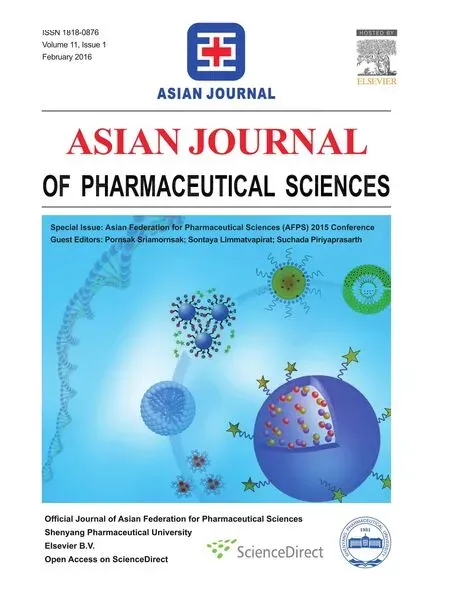Layer-by-layer nanostructured protein loaded nanoparticles:A feasibility study using lysozyme as model protein and chitosan as coating material
Thoms Kissel
aSchool of Pharmacy,Shenyang Pharmaceutical University,Wenhua Road 103,110016 Shenyang,China
bDepartment of Pharmaceutics and Biopharmacy,Phillips-Universit?t of Marburg,Ketzerbach 63,D-35032 Marburg,Germany
Layer-by-layer nanostructured protein loaded nanoparticles:A feasibility study using lysozyme as model protein and chitosan as coating material
Cuifang Caia,*,Shirui Maoa,Thomas Kisselb
aSchool of Pharmacy,Shenyang Pharmaceutical University,Wenhua Road 103,110016 Shenyang,China
bDepartment of Pharmaceutics and Biopharmacy,Phillips-Universit?t of Marburg,Ketzerbach 63,D-35032 Marburg,Germany
A R T I C L E I N F O
Article history:
Available online 25 November 2015
Chitosan
Nanoparticles
Lysozyme
Electrostatic interaction
Protein carrier
Layer-by-layer
Stabilization of proteins in delivery devices and design of appropriate protein carriers are major research issues due to the extreme sensitivity of proteins.Previously,negatively charged nanoparticles,consisting of poly(lactic-co-glycolic acid)(PLGA) and poly(styrene-co-4–styrene-sulfonate)(PSS),showed considerably high loading capacity for positively charged model protein lysozyme depending on the surface charge density of nanoparticles.Chitosan coated lysozyme loaded layer-bylayer protein delivery nanocarrier were prepared and the infuence of chitosan composition,concentration and initial protein loading on the release and stability of nanoparticles were investigated.
Nanoparticles were prepared by a solvent displacement method.Loading with oppositely charged model protein lysozyme and followed by chitosan coating were completed through electrostatic interaction between oppositely charged nanoparticle-protein,and nanoparticle-chitosan.Morphology of nanoparticles was investigated using scanning electron microscopy(SEM)and transmission electron microscopy(TEM). At a ratio of PLGA to PSS 10%and initial theoretical lysozymeloading 10%,the effect of chitosan(CS)(150 kDa)concentration on the properties of the lysozyme loaded nanoparticles is shown in Fig.1.The results indicate that the concentration of CS had a signifcant infuence on the particle size and zetapotential of all the resulting formulations investigated.More specifcally,the size of the CS-coated nanoparticles linearly increased upon addition of increasing amounts of CS from 244 nm to 606 nm(R2=0.9671)within the range of chitosan concentrations from 0 to 1.92 mg/ml.The SEM and AFM images of nanoparticles were shown in Fig.2.In addition,dissociation of lysozyme was dependent on polymer composite,irrespective of initial protein loading.Moreover,with this polymer coating more stable particles were obtained in PBS,without burst release within 24 hours.In light of these results,these novel polymer coated protein loaded nanoparticles with layerby-layer nanostructure could be suggested as promising new protein delivery systems with benefcial properties,i.e. protection of protein,controlled release,stability,and combined with potential properties of coated polymer.

Fig.1–Size(Z-Ave)(A)and zeta-potential(ZP)(B)of lysozyme-loaded nanoparticles after incubation with chitosan(150 kDa) solution at different concentrations(mean±S.D.,n=3)(A)and SEM images of nanoparticles at the chitosan concentration of 60(A)and 120 μg/ml(B),respectively.TEM images of uncoated nanoparticles(C)and coated nanoparticles(D)at the chitosan concentration of 120 μg/ml,respectively(B).
R E F E R E N C E S
[1]Osuna B,Vauthier C,Farabollini A,et al.Mucoadhesion mechanism of chitosan and thiolated chitosan-poly(isobutyl cyanoacrylate)core-shell nanoparticles.Biomaterials 2007;28:2233–2243.
[2]Zhang L,Sun M,Guo R,et al.Chitosan surface-modifed hydroxycamptothecin loaded nanoparticles with enhanced transport across Caco-2 cell monolayer.J Nanosci Nanotechnol 2006;6:2912–2920.
[3]Prego C,Fabre M,Torres D,et al.Effcacy and mechanism of action of chitosan nanocapsules for oral peptide delivery. Pharm Res 2006;23:549–556.
*E-mail address:bbpharmcai@sina.com.
Peer review under responsibility of Shenyang Pharmaceutical University.
http://dx.doi.org/10.1016/j.ajps.2015.10.046
1818-0876/?2016 Production and hosting by Elsevier B.V.on behalf of Shenyang Pharmaceutical University.This is an open access article under the CC BY-NC-ND license(http://creativecommons.org/licenses/by-nc-nd/4.0/).
 Asian Journal of Pharmacentical Sciences2016年1期
Asian Journal of Pharmacentical Sciences2016年1期
- Asian Journal of Pharmacentical Sciences的其它文章
- Determination of the antidepressant effect of mirtazapine augmented with caffeine using Swiss-albino mice
- Photosafety testing of dermally-applied chemicals based on photochemical and cassette-dosing pharmacokinetic data
- Biopharmaceutics classifcation system(BCS)-based biowaiver for immediate release solid oral dosage forms of moxifoxacin hydrochloride (Moxifox GPO)manufactured by the Government Pharmaceutical Organization(GPO)
- Bioequivalence study of abacavir/lamivudine (600/300-mg)tablets in healthy Thai volunteers under fasting conditions
- Evaluation of cytotoxic and infammatory properties of clove oil microemulsion in mice
- Analytical method development of pregabalin and related substances in extended release tablets containing polyethylene oxide
